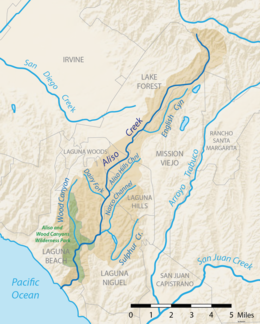
Back اليسو كريك ARZ Aliso Creek (suba sa Tinipong Bansa, Orange County) CEB Aliso Creek (comté d'Orange) French Aliso Creek SIMPLE
| Aliso Creek Alisos Creek, Los Alisos Creek[1] | |
|---|---|
 Aliso Creek flows underneath the Aliso Creek Road bridge before it enters Aliso and Wood Canyons Wilderness Park. | |
 Map of the Aliso Creek watershed showing major tributaries and cities | |
| Etymology | Rancho Cañada de los Alisos land grant; "Aliso" means alder or sycamore in Spanish. |
| Location | |
| Country | United States |
| State | California |
| Counties | Orange County |
| Cities | Laguna Beach, Laguna Niguel, Aliso Viejo, Laguna Woods, Laguna Hills, Lake Forest, Mission Viejo |
| Physical characteristics | |
| Source | Loma Ridge in the Santa Ana Mountains |
| • location | Cleveland National Forest north of Portola Hills |
| • coordinates | 33°42′10″N 117°37′20″W / 33.70278°N 117.62222°W[1] |
| • elevation | 1,704 ft (519 m)[1] |
| Mouth | Pacific Ocean |
• location | Aliso Beach Park, Laguna Beach |
• coordinates | 33°30′38″N 117°45′9″W / 33.51056°N 117.75250°W[1] |
• elevation | 0 ft (0 m)[1] |
| Length | 19.8 mi (31.9 km)[2] |
| Basin size | 34.9 sq mi (90 km2) |
| Discharge | |
| • location | Laguna Beach[3] |
| • average | 8 cu ft/s (0.23 m3/s)[3] |
| • minimum | 0 cu ft/s (0 m3/s) |
| • maximum | 5,400 cu ft/s (150 m3/s) |
| Basin features | |
| Tributaries | |
| • left | English Canyon Creek, Aliso Hills Channel, Sulphur Creek |
| • right | Munger Creek, Dairy Fork, Wood Canyon Creek |
Aliso Creek is a 19.8-mile (31.9 km)-long,[2] mostly urban stream in south Orange County, California. Originating in the Cleveland National Forest in the Santa Ana Mountains, it flows generally southwest and empties into the Pacific Ocean at Laguna Beach. The creek's watershed drains 34.9 square miles (90 km2), and it is joined by seven main tributaries. As of 2018, the watershed had a population of 144,000 divided among seven incorporated cities.[4]
Aliso Creek flows over highly erosive marine sedimentary rock of late Eocene to Pliocene age.[5] What would become the Aliso Creek watershed originally lay at the bottom of the Pacific Ocean, before being uplifted as recently as 10 million years ago. About 1.2 million years ago, the San Joaquin Hills began to uplift in the path of Aliso Creek. Occasionally swollen by wetter climates during glacial periods, the creek carved the deep water gap known today as Aliso Canyon, the main feature of Aliso and Wood Canyons Wilderness Park.
Historically, Aliso Creek served as the boundary between the Acjachemem (Juaneño) and Tongva (Gabrieleño) Native Americans. Spanish explorers and missionaries reached the area in the 1700s and established Mission San Juan Capistrano, whose lands included part of the Aliso Creek watershed. In the 1840s the watershed was divided between several Mexican land grants. After California became part of the United States, the ranchos were gradually partitioned and sold off to farmers and settlers; starting in the 1950s, real estate companies acquired most of the land for development.
By the 21st century, more than 70 percent of the Aliso Creek watershed was urbanized. Most of the creek's course has been channelized or otherwise impacted by development. Pollution and erosion from urban runoff have become chronic issues.[6][5] However, parts of the creek remain free flowing and provide important regional wildlife habitat, especially in the Aliso Canyon section. The creek has recently been the focus of projects to restore the stream channel and improve water quality.
- ^ a b c d e "Aliso Creek". Geographic Names Information System. United States Geological Survey, United States Department of the Interior. January 19, 1981. Retrieved March 19, 2019.
- ^ a b "CalFish 1:100k Hydrography". California Department of Fish and Game. Retrieved March 20, 2019. (1:100k Hydrography is a 1:100,000 scale stream based routed hydrography shapefile covering the state of California developed by California Department of Fish & Game (CDFG) and Pacific States Marine Fisheries Commission (PSMFC). The shapefile utilizes existing National Hydrography Database (NHD) 1:100,000 linework and attributes as well as Geographic Names Information System (GNIS) identifiers as guidelines to determine the stream networks that were combined into routes.)
- ^ a b Cite error: The named reference
South Laguna 2012was invoked but never defined (see the help page). - ^ "Aliso Creek Estuary Restoration Conceptual Restoration Plan" (PDF). Laguna Ocean Foundation. March 2018. Retrieved March 18, 2019.
- ^ a b O'Neil, Stephen; Christopher Corey; Nancy Sikes (October 2006). "Cultural Resources Inventory and Evaluation for the Proposed Aliso Creek Inn and Golf Course Project, City of Laguna Beach, Orange County, California". SWCA Cultural Resources Report Database No. 2005-115. SWCA Environmental Consultants.
- ^ "Surface Water Ambient Monitoring Program (SWAMP) Report on the San Juan Hydrologic Unit" (PDF). South California Coastal Water Recovery Project. Retrieved May 16, 2009.
© MMXXIII Rich X Search. We shall prevail. All rights reserved. Rich X Search
